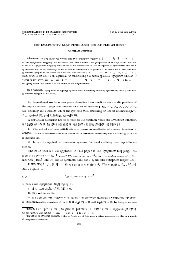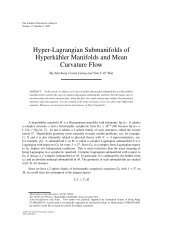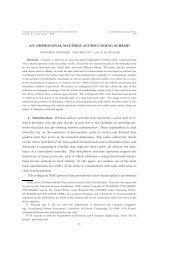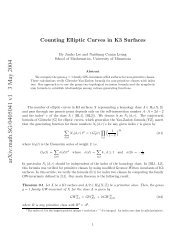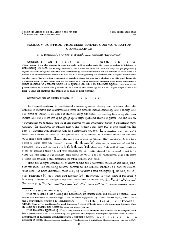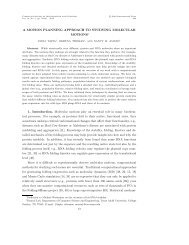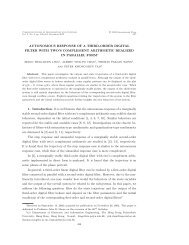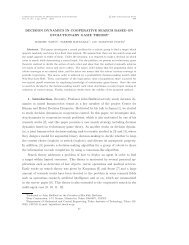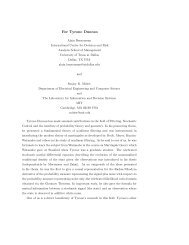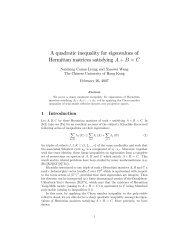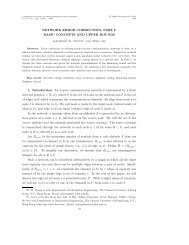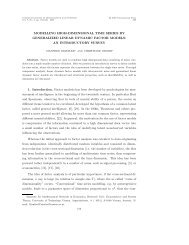Mirror Symmetry of Fourier$Mukai transformation for Elliptic Calabi ...
Mirror Symmetry of Fourier$Mukai transformation for Elliptic Calabi ...
Mirror Symmetry of Fourier$Mukai transformation for Elliptic Calabi ...
Create successful ePaper yourself
Turn your PDF publications into a flip-book with our unique Google optimized e-Paper software.
The usual SYZ trans<strong>for</strong>m which switches the …bers <strong>of</strong> a Lagrangian …bration<br />
V ! B to their duals will interchanges complex geometry and symplectic<br />
geometry. In order to stay within the symplectic geometry, we should take the<br />
…berwise dual to both Lagrangian …brations V ! B and V ! C.<br />
Taking dual to both T b and T c has the same e¤ect as taking dual to (T b + T c ) =T bc<br />
while keeping T bc …xed. This gives us the following new commutative diagram.<br />
U ! C 0<br />
# #<br />
B 0 ! D:<br />
Here B 0 (resp. C 0 ) is the total space <strong>of</strong> taking …berwise dual to the …bration<br />
B ! D (resp. C ! D). The …ber Tb 0 <strong>of</strong> U ! B0 is obtained by taking dual<br />
along the base <strong>of</strong> the …bration T b ! T b =T bc . This is the same as taking …berwise<br />
dual, up to conjugation with the duality <strong>of</strong> total spaces. The …ber <strong>of</strong> B 0 ! D<br />
is (T c =T bc ) and likewise <strong>for</strong> C 0 ! D.<br />
A more intrinsic way to describe this double dual process is as follow: The<br />
…ber <strong>of</strong> V ! D is a coisotropic subspace in V , say V d . The symplectic reduction<br />
V d = (see e.g. [25]) is another symplectic vector space. Then U is obtained by<br />
replacing V d = by its dual symplectic space from V .<br />
In terms <strong>of</strong> an explicit coordinate system on V given by x i ; x ; y i ; y with<br />
1 i n q and n q + 1 n, then we have,<br />
V ! C<br />
# #<br />
B ! D<br />
with coordinates<br />
y i ; y <br />
x ; x i ! y <br />
x i<br />
;<br />
# #<br />
x ; x i ! x i<br />
and<br />
U ! C 0<br />
# #<br />
B 0 ! D<br />
with coordinates<br />
y i ; y<br />
<br />
x ; x i ! y <br />
x<br />
i<br />
:<br />
# #<br />
x ; x i ! x i<br />
The Lagrangian conditions actually imply that B 0 = C, C 0 = B and U = V .<br />
We now return back to the general symplectic manifolds situation.<br />
4.2.3 Twin Lagrangian …brations<br />
First we recall that every …ber <strong>of</strong> a Lagrangian …bration, say : X ! B, has a<br />
natural a¢ ne structure.<br />
De…nition 2 Let (X; !) be a symplectic manifold <strong>of</strong> dimension 2n and : X !<br />
B and p : X ! C are two Lagrangian …brations on X with Lagrangian sections.<br />
We call this a twin Lagrangian …bration <strong>of</strong> index q if <strong>for</strong> general b 2 B and<br />
c 2 C with p 1 (c) \ 1 (b) nonempty, then it is an a¢ ne subspace <strong>of</strong> 1 (b)<br />
<strong>of</strong> codimension q. We denote such a structure as B <br />
X ! p C<br />
11




